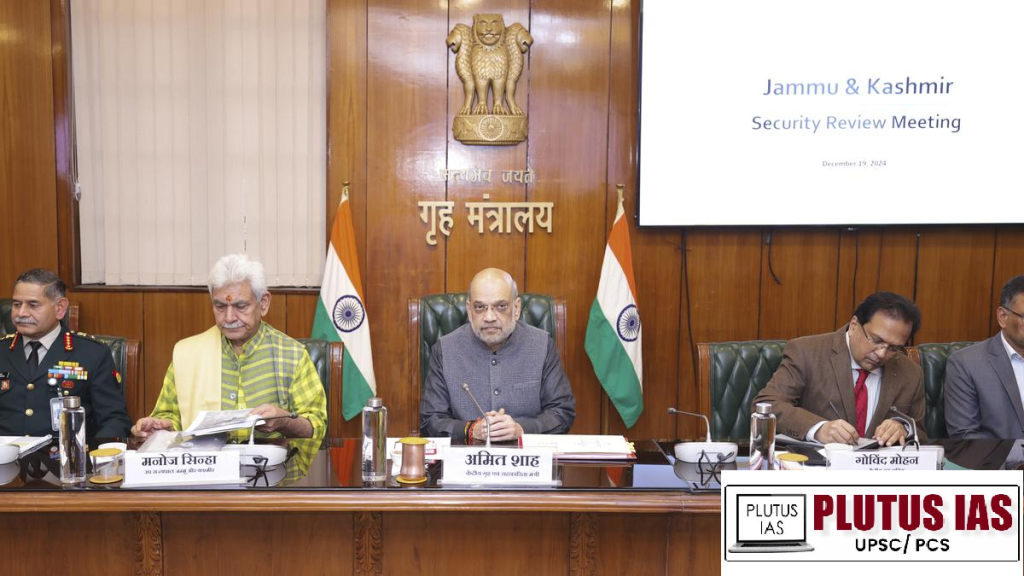21 Dec Terrorism: A Growing Challenge to Internal Security
SYLLABUS MAPPING:
GS-3- Internal Security-Terrorism: A Growing Challenge to Internal Security
FOR PRELIMS:
What is terrorism, and what are the forms of terrorism? Various counter-terrorism measures
FOR MAINS:
Why is terrorism a major challenge in Jammu & Kashmir? Discuss the factors contributing to the security situation in the region.
Why in the news?

Terrorism:
Forms of Terrorism
1. International Terrorism: International terrorism is driven by foreign terrorist organizations or external influences, often transcending national borders.
Indian Context: India has been a victim of cross-border terrorism, especially from Pakistan-based groups like Lashkar-e-Taiba (LeT) and Jaish-e-Mohammed (JeM). Example The 26/11 Mumbai attacks (2008), carried out by LeT, involved coordinated assaults on public spaces, killing over 170 people.
2. Domestic Terrorism: Domestic terrorism arises from social, political, or ideological objectives within the terrorist’s home country.
Indian Context: India faces domestic terrorism challenges such as Maoist insurgency (Left-Wing Extremism), which operates in states like Chhattisgarh, Jharkhand, and Odisha. Example The Dantewada Naxal attack (2010), in which 76 CRPF personnel were killed by Maoist insurgents.
Why terrorism is a major challenge to internal security
| Challenge | Description |
|---|---|
| Threat to Safety | Terrorist attacks cause the loss of innocent lives, leading to widespread fear and insecurity in society. |
| Political Instability | Terrorism undermines government authority, challenges legitimacy, and erodes public trust in institutions. |
| Economic Impact | Destruction of infrastructure, disrupted commerce, and increased security costs harm the economy. |
| Social Division | Terrorism induces fear, trauma, and social divisions, leading to mistrust and potential radicalization. |
| Unpredictable Tactics | Terrorists use unconventional tactics, making it difficult for national security forces to predict or prevent attacks. |
| Radicalization | Terrorism fosters radicalization, especially among vulnerable groups, leading to the growth of extremist ideologies. |
| International Strain | Cross-border terrorism strains diplomatic relations and reduces international cooperation. |
| Long-term Effects | The aftermath of attacks continues to affect national security, with heightened security measures and public trauma. |
Why terrorism is more Prelevant in Jammu & Kashmir:
1. Geopolitical Conflict: Jammu & Kashmir is a disputed region between India and Pakistan, fueling cross-border terrorism.
2. Cross-Border Infiltration: Pakistan-based militant groups infiltrate the region, increasing terrorist activities.
3. Religious and Ideological Goals: Militant groups seek to establish an Islamic state or separate Kashmir from India.
4. Local Grievances: Political unrest, alienation, and dissatisfaction create fertile ground for extremism.
5. Youth Radicalization: Limited economic opportunities and political discontent led to recruitment by militant groups.
6. Strategic Importance: The region’s location makes it a focal point for external and internal security concerns.
7. Article 370 Abrogation: The removal of Jammu & Kashmir’s special status increased unrest and violence.
8. Security Operations: Military actions often lead to civilian casualties, further fueling radicalization.
9. Social Media: Terrorist groups use social media for propaganda and recruitment.
Various counter-terrorism measures:
| Counter-Terrorism Measure | Purpose |
|---|---|
| UAPA (Unlawful Activities Prevention Act) | Designates organizations as terrorist groups and allows detention without charge. |
| NIA (National Investigation Agency) | Investigates terrorism cases, especially those with international links. |
| ATS (Anti-Terrorism Squad) – State Level | Focuses on preventing and responding to local terrorist threats. |
| NSA (National Security Act) – 1980 | Allows preventive detention of individuals threatening national security. |
| Fencing of Borders | Prevents cross-border infiltration by terrorists. |
| Surveillance & Intelligence Sharing | Enhances monitoring of suspected terrorists and shares intelligence across agencies. |
| Counter-Radicalization Programs | Focuses on preventing recruitment by extremist groups through community engagement. |
What are the issues in counter-terrorism efforts?
1. Lack of International Cooperation: Countries often prioritize different interests, hindering information sharing and global coordination.
2. Radicalization: Extremist ideologies spread through social media, leading to increased recruitment, especially among youth.
3. State-Sponsored Terrorism: Some nations support or shelter terrorist groups, complicating global counter-terrorism efforts.
5. Lack of Coordination Among Security Agencies: Fragmented agencies lead to inefficiencies, delays, and missed opportunities in responding to threats.
6. Human Rights Violations: Counter-terrorism measures sometimes infringe on human rights, causing distrust and alienation among communities.
7. Evolving Tactics of Terrorists: Terrorists adapt to new technologies and tactics, such as cyber-attacks and lone-wolf operations, complicating responses.
8. Funding and Resource Shortages: Terrorist groups often have significant funding, while counter-terrorism efforts face resource constraints.
9. Public Support: Heavy-handed tactics can erode public trust, making counter-terrorism less effective and potentially fueling radicalization.
Way forward:
1. Criminalizing Terrorist Offenses: Strengthen laws to criminalize all terrorist activities and ensure effective prosecution.
2. Strengthening International Cooperation: Enhance global intelligence-sharing and create unified legal standards for tackling terrorism.
3. Countering the Use of New Technologies: Regulate online platforms and improve cybersecurity to prevent terrorist exploitation of technology.
4. Addressing the Threat of Foreign Terrorist Fighters: Strengthen border control measures and develop reintegration programs for returning foreign fighters.
5. Promoting a Whole-of-Society Approach: Engage communities, promote counter-narratives, and educate the public to prevent radicalization.
6. Counter-Terrorism and Counter-Radicalisation (CTCR) Division: Coordinate efforts across agencies to prevent radicalization and ensure integrated counter-terrorism strategies.
Conclusion
Prelims Question:
Q.Consider the following statements:
1. Terrorism is primarily driven by the deliberate use of violence to achieve political, ideological, or religious objectives.
2. The Jammu & Kashmir region faces terrorism due to its geopolitical conflict, cross-border infiltration, and internal social grievances.
3. The National Investigation Agency (NIA) is responsible for addressing terrorism issues related only to international groups, not domestic ones.
How many of the statements given above are correct?
A. Only one
B. Only two
C. All three
D. None
Answer: B
Mains Question:
Q. Discuss the various challenges faced by India in its counter-terrorism efforts, particularly in Jammu & Kashmir, and suggest a way forward to enhance national security.
(250 words, 15 marks)




No Comments